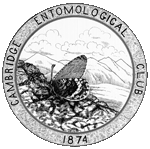
| January 2008: Psyche has a new publisher, Hindawi Publishing, and is accepting submissions |
Article beginning on page 351.
Psyche 3:351, 1880.
Full text (searchable PDF)
Durable link: http://psyche.entclub.org/3/3-351.html
The following unprocessed text is extracted from the PDF file, and is likely to be both incomplete and full of errors. Please consult the PDF file for the complete article.
PSYCHE.
A NEW MUSEUM PEST, TROGODERMA TARSALE MELS. BY FRANCIS HUNTINGTON SNOW, LAWRENCE, KANSAS. In Dr. Hagen's list of "Museum pests
observed in Cambridge," published in the Proceedings of the Boston Society of Nat- ural History, vol. 20, I find no mention of the above species, and in order that
eastern collectors may guard against its introduction into their cabinets I give the following brigf description of its larva and pupa.
LARVA.
Measurements, when full grown : length,
exclusive of caudal hairs, 5.4 mm. ; inclu- ding caudal hairs, 8 mm. ; breadth 1 .G mm. Upper dermal surface reddish brown ;
lower surface vitreous white ; entire sur- face covered with short, soft, yellowish brown hairs ; each stigmatic orifice sur- rounded by a stellate tuft of longer setose hairs, of variable length and of the same color as the general hairy covering. The upper surface of the last three segments is entirely concealed by a dense mass of short, erect, dark brown hairs so nearly equal in length as to present the appearance of hav- ing been cut off with shears, like the bris- tles of a very compact brush. The sides
of the upper surface of the two preceding segments have a similar covering. The
two caudal appendages, which attain one
half the length of the body and are notice- ably separated when the larva is in motion, often appear to the eye to consist each of a single, stout, elongated bristle, but, under the microscope, are seen to be composed in each case of from twenty to twenty-five
separate hairs.
Larvae infesting cabinet specimens in the autumn remain in their hosts during late autumn and winter. apparently in an inac- tive condition. From 1 March to 1 April, according to the season, they begin to trans- form into the pupal state, for which pur- pose, unless the infested specimen is of large size, they come forth from their
places of concealment and are easily ob- served and destroyed.
================================================================================
PSYCHE.
PUPA.
Length, 4 mm. ; breadth, 2 mm.
Enclosed within the larval skin, and
visible only from above, where the larval skin is longitudinally split open along the median dorsal line from head to anal seg- ment. Abruptly narrows to a point at the anal extremity. Removed from larval
skin, the entire surface of the pupa is seen to be covered with short, soft, light yellow- ish brown hairs, except at the centre of dorsal surface which contains three minute transverse incisions or furrows. The antc- rior margin of each furrow is straight while the posterior margin is curved. Examined under the microscope, both margins of each incision are seen to be minutely dentate, but the teeth of the posterior margins are ft
more prominent than those of the anterior margins. The inckions beingin the outer
layer of the skin only, these minute teeth may be of use in fixing the pupal skin
while the imago emerges from it.
The iinagos, first appearing about the
middle of March, continue to appear during all the spring' and summer months.
For several years this was the only
museum pest whose presence was dreaded
in the entomologica,l cabinets of the Uni- versity of Kansas, but for the past three years A11t1'1,renus mius has become quite as formidable a foe, having' been introduced into the building' in some eastern bird skins. Careful watching: and the use of tight boxes have prevented serious damage to the col- lections from either of these pests.
ORGANS, PROBABLY DEFENSIVE IN FUNCTION, IN THE LARVA OF HYPERCHIRIA VAKIA, WALK. (SATURNTA 10, I-IARRTS). BY GEORGE DIMMOCK, CAMBRIDGE, MASS.
In examining a larva of Hyperchi7-ia
vc~ria lately I found on each side a protru- sile organ just posterior to, and a trifle below the level of the stigmata of the
'
fourth segment, and a similar organ in the same position relative to the stigmata
of the tenth segment, these segments
beingcounted from and excludingthe
head.
These organs, when retracted, exhibit
nothing more than an irregular opening,
about half a millimetre in diameter, situa- ted in the reddish lateral line which extends from the anterior part of the fourth seg- ment to the posterior extremity of the
larva. In this position they may be easily mistaken for some of the folds of the skin which are numerous along the lateral parts of this larva when at rest.
If the larva be disturbed by slightly
touching the spines with which it is covered, and at the same time attention be given to the above-mentioned irregular opening's, which should be observed under a lens,
each opening will be seen to evaginate and to re-invaginate alternately. When evag- inated to about a half a millimetre in
height above the surrounding skin the
appearance of the organ is very similar to that of a minute sea-anemone or actinia
================================================================================
Volume 3 table of contents